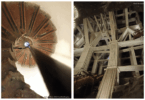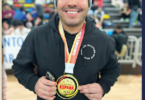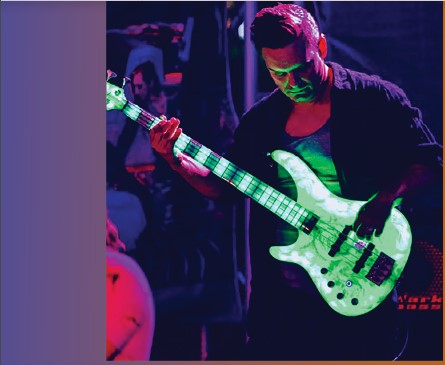
By Christopher Humphreys, The Anfield Group, USA
One of my earliest memories of being exposed to music by my parents was an almost weekly ritual from about age 4-7 years old where my father would take me to Sam Goody Records in Manassas VA to buy the 45 RPM vinyl records of the latest and greatest in pop music of the time.
This was around 1981-1986 and the dawn of MTV and the boom of Music Videos where, as the famous Buggles song goes, “video killed the radio star.” One week it might be Duran Duran, Huey Lewis and the News, or even The Cars latest single that I’d choose at Sam Goody. The next week, it might be Michael Jackson, Kool and the Gang, The Commodores, or Lionel Ritchie. I never gave it a second thought as a kid that people didn’t have such diverse and eclectic tastes in music. As I got older, I came to the realization that my parents exposing me and encouraging me to embrace all styles of music had to be somewhat intentional on their part.
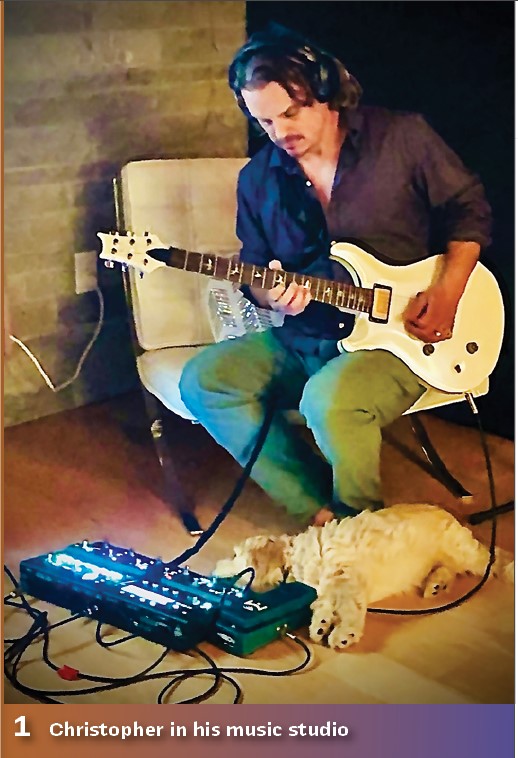
At age 4 somehow my parents thought I had the intellectual capacity to be a musician and I started piano lessons. It was also about this time that MTV continued to become the moniker given to my generation.
As a result, I can attribute the influence of four bands/artists of that early MTV era where I knew I wanted to be a musician myself and not just because my parents made me. Those artists were The Police, U2, Van Halen and Prince. Their music set off something in me at a very early age where I knew I wanted to dream of playing music just like them.
This is where my obsession with the guitar began. I begged my parents to let me take guitar lessons for what seemed like an eternity at the time to no avail. While I continued to study piano and play recitals, I still saw it as a chore- a chore that my parents and grandparents were extremely encouraging and supportive both emotional and financially, so I guess I didn’t completely hate it?

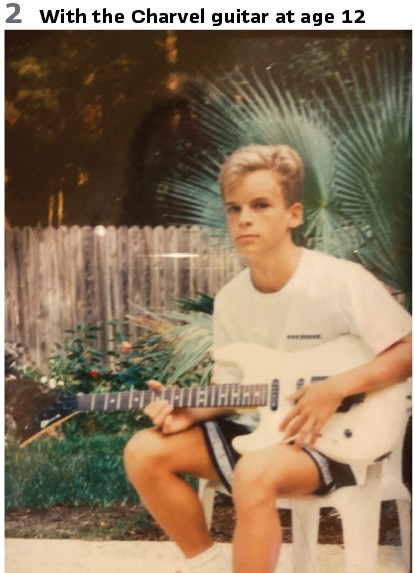
In 1989 we moved from Northern Virginia to Gainesville Florida. There I was blessed to find a piano teacher that also taught guitar. My parents had obviously consulted with my Piano teacher on my aptitude to learn guitar.
The only advice they didn’t take from my instructor was his recommendation for me to learn how to play right-handed even though I’m left-handed. The logic being that it’d be a whole lot easier for me to access right-handed guitars and also read guitar tablature (i.e the strings and fret numbers). Despite that advice, on my 12th birthday, my parents finally gave me my 1st electric guitar- a Left-Handed White Charvel/Jackson Soloist that they somehow found in a pawn shop somewhere on campus at the University of Florida. (see Figure 2).
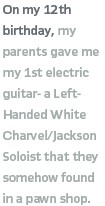
The only catch my parents gave me was that if I wanted to learn the guitar, I had to stick with piano. Obviously, I agreed- reluctantly as I might have been at the time. Little did I know how grateful I’d be later in life that they forced me to honor that commitment as it afforded me the classical training in music theory combined with my ability to play by ear as well.
Most musicians would consider themselves one or the other- not both necessarily. In fact, to this day when I play guitar or any instrument, I still visualize the piano keyboard when I read music.
I also describe myself as a “jack of all trades but master of none” musician. Because of my ability to transpose my piano training to multiple instruments at an early age (don’t ask me how,) I could quickly learn other instruments.
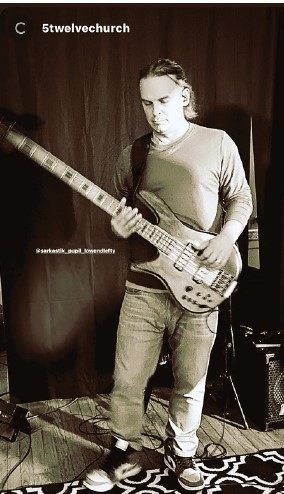
I also lacked confidence in my abilities and was, and still am, extremely hard on myself. Nevertheless, that lack of confidence that I wouldn’t be the next Eddie Van Halen, made me realize everyone always needs a bass player. I also figured out that it’s the most selfless yet thankless instrument in any band that no one notices unless it’s not there. Additionally, the bass line of a song is the foundation of every song that affords the lead guitarist and flamboyant singers to show off. At the same time, I idolized bassists of the day like Sting (The Police), Geddy Lee (Rush), Bootsy Collins (P-Funk), Tony Levin (Peter Gabriel/King Crimson) and by studying their approach to the bass, it improved my abilities in how to structure and compose music.
So why all the guitars? As a left-handed guitarist, it was horrible to have to watch all the right-handed players pulling any guitar they’d want off the wall at a music store and all I could do was sulk in the corner. Actually, this very scenario motivated me to teach myself how to play a right-handed guitar backwards. It was out of this frustration that I began to dream of a day where I could afford a guitar collection where I designed all of them just for me.
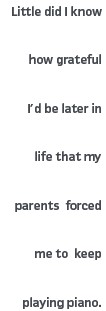
Designing my own custom builds and being lucky enough to seek out rare left-handed guitars and basses that I dreamt of as a kid, has resulted in a bit of an obsession. All this being said, in 2019, I began an over 2-year process with Paul Reed Smith’s Private Stock where my concept was brought to reality and I was able to hand select every single component of the build- body woods, neck/fretboard woods, inlays, electronics, etc. The result was my first “Chris Humphreys Signature” guitar.
Further vindication for me is that PRS Guitars now has right-handed players requesting my guitar, by name, for themselves. That irony is not lost on me at all! (Figure 4 – my Private Stock).
Over many years of taking such a hands-on approach to the guitars I’ve built, I have learned far more about how wood materials, shapes, and carves effect the sound/tone. My only frame of reference previously was listening to my favorite guitarists and studying what guitars they played to get the sound that becomes so signature to their style of music and technique.
Now, I actually have the engineering knowledge after building my own to understand why my musical influences are able to achieve those tones.

Let’s start with body. These are the 3 main options:
- Solid body
- Hollow-body
- Semi-hollow-body
For an electric guitar- a solid-body means there’s no chambering and the solid piece of wood has to resonate with the electro-magnetic pickups and circuit that’s installed.
A hollow-body guitar usually has two long f-shaped holes in the top. They are actually called “F Holes” and are identical to what someone would see on orchestral stringed instruments like a violin or cello. The hollow effect on the wood adds a more natural resonance to the sound of the guitar.
Lastly, a semi-hollow is just that- instead of two f-holes like a hollow-body, there’s just one. A semi-hollow is that happy medium to achieve a somewhat hollow resonance combined with the weight of a solid body top.
Again, there are way too many options for me to cover in great depth when it comes to wood selections. Just know that every different type of wood has an equally different sound and feel.
Since this is an engineering publication, I’ll cover the electronic components briefly. Just like the wood selection, pickup selection is just as crucial when building a guitar.
The pickup selection could be considered as the “heart” of the instrument. It converts string vibrations into electric signals and is embedded in the body of the guitar right beneath the strings.
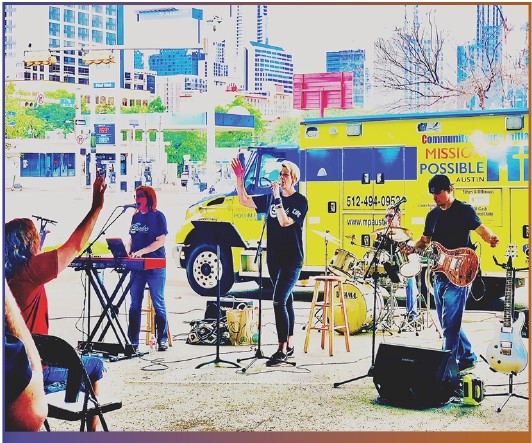
An electric guitar pickup consists of:
- Black bobbin with six magnetic bars inserted, and a
- Material such as enameled wire wound around the magnets.
Six magnets are used to better pick up the sound from the six stings.
Electric guitar pickups can include one or two coils. A pickup with one coil is called a “single coil pickup,” while one with two coils is called a “humbucking pickup.”
Although coils are susceptible to outside noise, the two coils in a humbucking pickup cancel out each other’s noise (hum cancellation), helping to reduce noise. Conversely, single coil pickups do not perform any noise cancellation, but offer a crisp and clean high-pitched tone.
Single coil, double coil, and humbuckers are the three common pickup types. The combinations are endless when configuring a build.
For sake of familiar reference for people unfamiliar with these terms, I’ll offer a simple visual for the two most common pickup configurations:
- A Fender Stratocaster, which is the signature guitar of music legends like Jimi Hendrix, Stevie Ray Vaughan, and Eric Clapton, have three single-coil pickups
- On a Gibson Les Paul, played famously by Jimi Page (Led Zeppelin), Alex Lifeson (Rush), and Slash (Guns n Roses) to name a few, has two humbuckers
If you are at all familiar of any of these artists, when you listen to them now, you may be able to understand the variances in their sounds and playing styles and hear the difference with the science behind it.
I have nearly 20 different guitars and basses in my collection and each one has a personal significance and story behind it that I can never take for granted and appreciate way more than any right-handed player could.
While I play PRS Guitars exclusively most of the time, I still own legendary Gibson and Fender electric guitars out of sheer respect.
My most cherished guitar is still that pawn shop Charvel/Jackson my parents bought me that started it all on my 12th birthday over 30 years ago- even though I have a guitar named after me and built by one of the world’s greatest guitar builders.
As a resident of Austin Texas, I’m obviously fortunate enough to be able to play at any number of bars, recording studios, classrooms, and churches every night of the week where I actually put every guitar I own to great use.
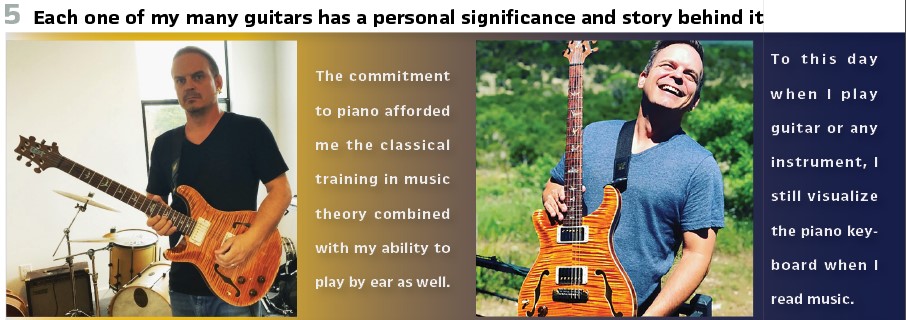
Biography:

Christopher Humphreys currently serves as the CEO and founder of The Anfield Group (www.theanfieldgroup.com) based in Austin TX. Throughout his 20-year career, he has established himself as an internationally recognized thought leader and evangelist in the industry verticals of Cybersecurity, Critical Infrastructure Protection (CIP), Intelligence Operations, Data Privacy and Regulatory Compliance. Prior to establishing The Anfield Group, he held executive positions at a variety of Federal agencies including DHS, NSA, and DIA as well as representing National Regulators, Electric Utilities, and Technology Startups.
Outside of work, Chris is an established musician and former professional soccer player. Although he was raised in Washington DC and Gainesville FL, he has called Austin TX home for the past 15 years.




